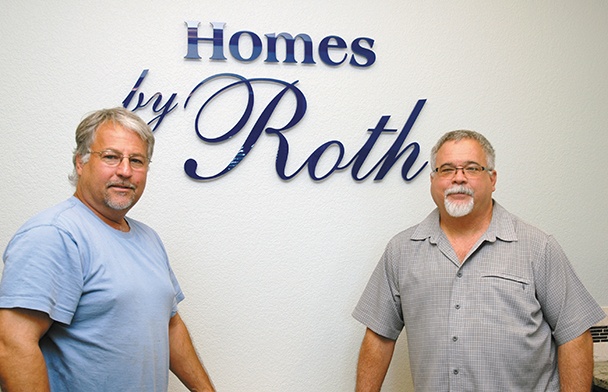Homes by Roth Takes on Tuscany Development
by May 25, 2015 12:00 am 1,048 views

It’s referred to by those in the construction and real estate industry as the million-dollar wall.
The 6-foot-tall brick structure surrounds roughly 104 acres of real estate just off Highway 72, about five miles west of Bentonville, originally planned a decade ago to rise from the ground as one of the area’s premier upscale neighborhoods.
Phase I of the Tuscany subdivision — catty-cornered from the prestigious Stonebriar/Talamore neighborhood — was officially platted in October 2005 with 71 single-family lots. But like so many residential developments of that time, it languished under the weight of a poor economy, and, in Tuscany’s case, a legal wrangling and a personal bankruptcy.
Take the scenic drive out to Tuscany today and you’ll find just a handful of houses inside the wall. The original property developers built just five houses and sold only 13 lots.
But a pair of million-dollar land deals within the past year have the development poised to realize its potential, and its future now sits squarely on the shoulders of one of the area’s most established home builders — Homes By Roth.
One year ago, HBR, led by brothers Randy and Jeff Roth, closed a $3.07 million deal to purchase the 58 undeveloped lots in Tuscany’s Phase I.
Fayetteville engineering firm Blew & Associates submitted the tract split plan to the city of Centerton last summer, and HBR has since built 11 homes in Phase I.
The remaining acreage is headed the Roths way, too. In April, an entity controlled by the Chambers family — namesake of Danville-based Chambers Bank — paid $1 million for 46.5 acres of undeveloped land in Tuscany.
The end game for the property, according to Chambers Bank vice president J.R. Meeks, who focuses on reducing the bank’s OREO portfolio, is to develop Phases II (69) and III (41) into 110 additional lots, and then sell the property to the Roth brothers to build out.
Blew & Associates is the engineer for that project, as well.
“We’re hoping to start development on that at the end of this month,” Meeks said. “Conservatively, within a year, we’d hope to have it ready for building.”
Meeks also noted that construction in Phases II and III should be well under way about the time the doors open to Bentonville West High School. The district’s second high school is less than a quarter-mile from Tuscany, and will open to students in the fall of 2016.
In the Beginning
The original Tuscany developers were construction executive Neil Johnson of Springdale and commercial real estate businessman John David Lindsey of Fayetteville, through an entity called Tuscany LLC.
Tuscany acquired the property in May 2004 for $2.8 million in a deal that was financed by Chambers Bank. Lilli Belle Lown and Melvin Earl and Judy D. Coffelt were the sellers.
Lindsey’s half of the entity, however, later fell victim to his personal bankruptcy in 2010, leaving Johnson as the sole developer.
Johnson and Lindsey drew immediate attention to the project in 2004 by erecting a 36-foot tower, serving as an entrance to the subdivision and connecting to a mile-long fence surrounding the entire development.
As reported by the Northwest Arkansas Business Journal in August 2004, Johnson went to great lengths to achieve the aged look of the tower.
He bought the salvage from five buildings in Charleston, South Carolina, and then hauled about 50,000 bricks back to Centerton. It took 21 trucks a day and a half to haul those 60 loads.
Johnson never disclosed how much he spent on the bricks, but said the entrance cost at least $750,000 to build, thus the “million-dollar wall” moniker.
By the Numbers
Randy Roth, 51, and Jeff Roth, 52, started their company in 1991, and average between 150 and 175 homes annually, ranging as far north as the Branson, Missouri, suburbs down to the River Valley.
They currently have activity going throughout Northwest Arkansas, from Woods Creek in Bentonville, Cross Creek in Rogers, Tamarron and Sienna Estates in Centerton and Summit Place in Fayetteville, another dead subdivision that HBR rescued last December when it paid $2.45 million for 58 lots.
“Our [homes] really start at 3,000 SF but that’s been creeping up to 3,500,” Randy said. “There are more and more requests for bigger houses and more bedrooms.”
The price point at Tuscany will start at $124 per SF, but the market may drive that number to $128, Jeff said. He added the homes will have all the “bells and whistles” including smart home technology, custom cabinets, granite countertops, brick and stone exteriors and central vacuum systems.
HBR may also be the first area home builder to pull the trigger on a new in-house amenity — charging stations for electric cars.
“We may not be going to that just yet, but it’s coming,” Randy said.
While heavy construction activity may still be several months out, HBR will get started soon on the construction of what it hopes will be Tuscany’s major recruiting card — a common area for a Tuscany Property Owners Association, anchored by a 2,727-SF clubhouse.
Chris Shirley and Isaac Moran with Ozarchitecture Inc. of Rogers have designed the facility on a 1.79-acre lot. The common area will also include a playground, basketball court and in-ground swimming pool.
“It will be the largest size in-ground pool that is allowed by the state,” Jeff said.
